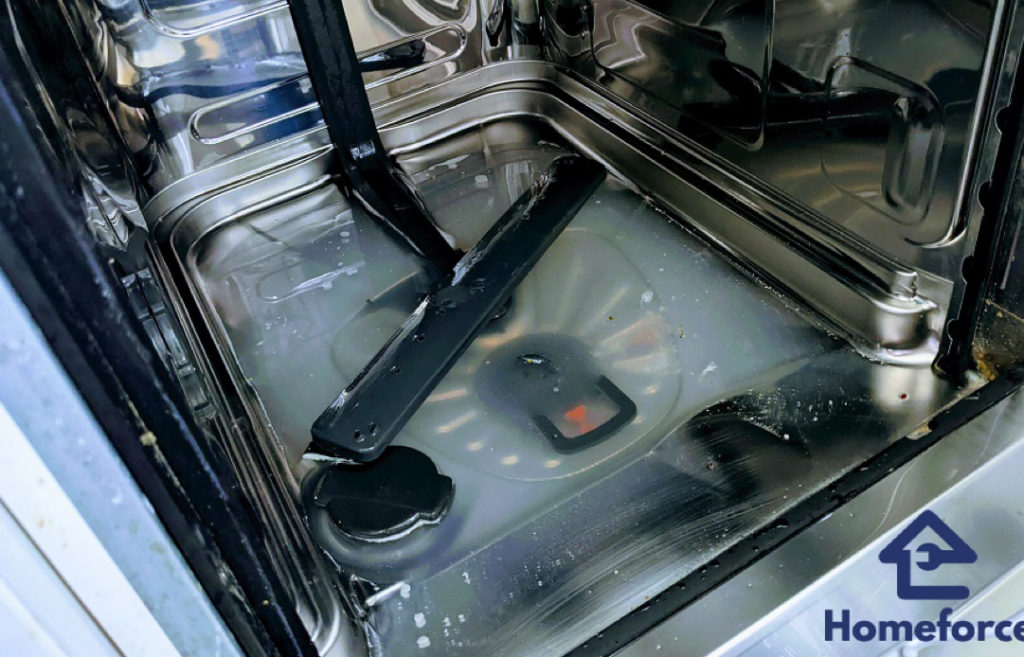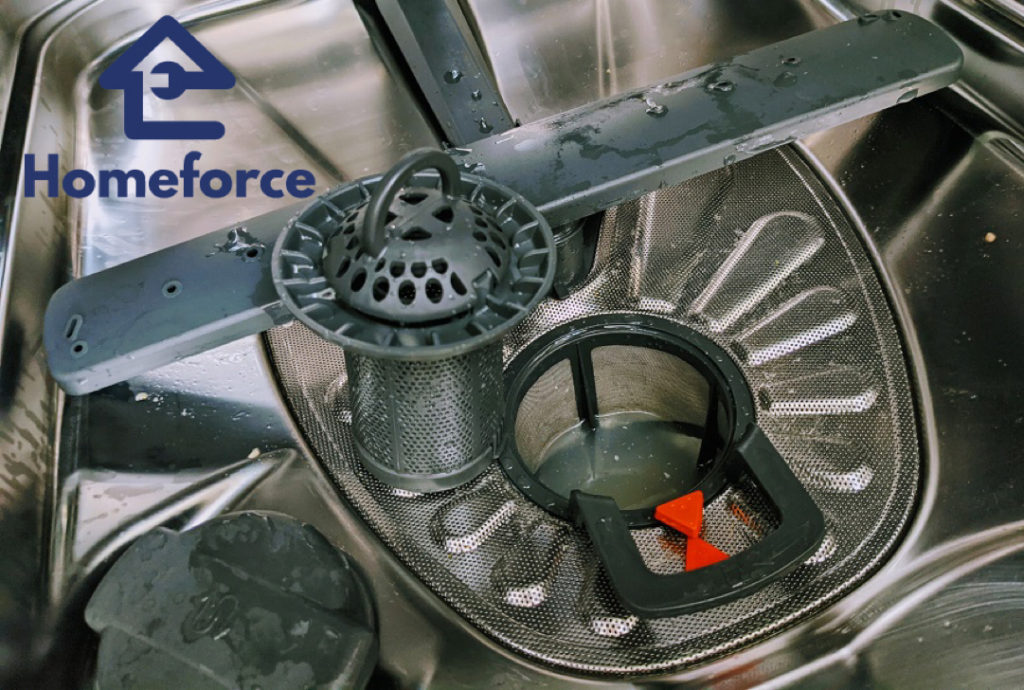Written On
Tue 2nd August 2022
Written By
Homeforce
Category
Guides
Share This
Getting the dishes done after a busy day is a chore, but it can be even more frustrating if there’s water in the bottom of the dishwasher.
If you don’t have an appliance plan to help with unforeseen problems and your crucial kitchen equipment breaks down, you might need to try to tackle the problem yourself or pay for a repair.
Join us to discover why you might find a pool of grimy water at the bottom of your dishwasher happening and some ways you might be able to fix it yourself.
Let’s hit the mini answer first, before diving into more water at the bottom of the dishwasher details. Here are 7 of the top reasons why there is water in the bottom of your dishwasher
- Clogged filter
- Broken or clogged drain hose
- Malfunctioning drain pump
- Air gap clog
- Error using the dishwasher
- Poor maintenance
- Broken parts
So with the brief nailed, so you can understand more about water in the bottom of your dishwasher, let’s uncover why it might be happening.
Why is there water in the bottom of the dishwasher?
Discovering a pool of water in the bottom of your dishwasher can be frustrating but there are some reasons why it might be happening.
Sometimes standing water in the bottom could be a sign of broken parts and you may need a dishwasher repair engineer near you to replace or repair the broken parts.
However, it could be just a small problem that you can fix yourself.
If there is excess food sediment in any of the above dishwasher parts, the dishwasher won’t be able to drain properly. This is why you may have a pool of stagnant water sitting at the bottom of your machine.
Clogs
Top of the list of 7 reasons why there’s water in the bottom of a dishwasher is a blockage.
A dishwasher can really take a hammering when it comes to loose food falling off plates and dishes.
Over time this can cause a blockage of important working parts such as the filter, drain hose and even the drain pump.
The easiest way to avoid food debris clogging up a dishwasher’s crucial parts is by rinsing dishes and plates before loading.
Top of the list of 7 reasons why there’s water in the bottom of a dishwasher is a blockage.
Broken Parts
A dishwasher is a very hard-working member of your kitchen.
Whether you have a family, live in a shared house or even if you live alone, pots and pans quickly stack up!
This can mean parts wear out quicker than you would hope.
If you think it could be a broken part causing water in the bottom of your dust washer, then you will need to find high-quality professional appliance engineers in your area to get it solved quickly and safely.
The best appliance engineers in the U.K. will be able to give you a speedy quote and also give you advice on appliance plans to save you from any future hassle.
Poor Maintenance can cause water in the bottom of dishwashers
It can be easy to simply continually load your dishwasher day after day without giving its maintenance much thought. Busy days mean it might not be your top priority!
However, to keep your dishwasher from having soggy pools of stagnant water sloshing around in the bottom, it’s important to regularly maintain it.

To keep your dishwasher in top condition, here are a few of our recommendations.
- Clean and inspect the spray arm
- Empty the drain basket
- Check the hoses
- Unclog any filters
Consult your owner’s manual for how often you need to perform these tasks. Do them every 6 months as a general guide.
How do I fix a dishwasher with water at the bottom?
Follow our tips below on how to get your dishwasher up and running again. Start with the filter and if that still doesn’t solve the problem, you could try cleaning the drain hose.
If this still doesn’t work then it might be time to get a repair.
Appliance repairs are often the last thing you budget for and can come as a shock to your cash flow. So it could be a good time to think about an appliance plan to protect you from unforeseen kitchen disasters.
Our Nationwide team of engineers will remove the stagnant pool in your dishwasher, getting you back on track with your dishes straight away.
Clean the filter
The filter is usually to be found at the bottom of your dishwasher, if you can’t see it, then take a look at the product manual for more direction.
Depending on the brand, some dishwasher filters are self-cleaning, whereas others will require you to keep them clean and free from food debris.
The filter’s main job is to catch excess food particles that make their way into the machine during the wash cycle. This way, the water is kept as clean as possible during the cleaning process.
Follow our 7 easy steps on how to clean the filter.
- Remove the rack which holds the dishes, plates, etc
- Unlock the filter unit (use your manual to locate it)
- To unlock it, unscrew the cylindrical filter by carefully unscrewing it
- Under a running tap, clean the filters
- Gently clean around the inside of the filter to remove any lodged food particles with a soft brush
- You can also leave the filter soaking in a bowl of soapy water, but make sure you rinse it thoroughly
- Make sure the arrows on the filter match up, replace the filter

DIY dishwasher drain
- Turn off the dishwasher: To ensure your safety, always switch off appliances before attempting any type of maintenance work.
- Remove all dishes and crockery: The first task is to remove all crockery, dishes and cutlery before attempting to drain it. Then remove the dust washer rack at the bottom of the machine. These are usually easily removed and replaced due to them being attached with runners. Once you’ve removed the dishwasher rack, you will be able to more easily access any water in the bottom of the dishwasher.
- Remove the water in the bottom of the dishwasher: Using towels and a jug if possible, remove as much water from the bottom of the dishwasher as you can. Once most of the water is gone, you can deal with the resume with paper towels to soak up any remaining.
- Check the drain hose: The drain hose is usually located under the sink or behind your dishwasher. Pull the dishwasher away from the wall for easy access. This is the hose which links the hose to the sink outlet pipe.
- Clean the drain hose: Put a shallow pan or dish under the hose to catch any spills from inside the pipe. Then disconnect it by using pliers to either remove or loosen the clamp on the hose. Once it’s removed you can remove any debris and food particles. An old wire coat hanger that’s been straightened will do a good job of getting into hard-to-reach areas.
And to end on…
So we hope that’s helped you troubleshoot why there is water on the bottom of the dishwasher and some ways you can try to get it working properly again.
Remember, good maintenance is always better than a cure, so make sure you pencil in a diary date once every six months for some simple dishwasher maintenance, and easier still, why not get your appliances protected.
If you have tried some of the steps to unclog your filter or drain hose and the dishwasher is still full of water.